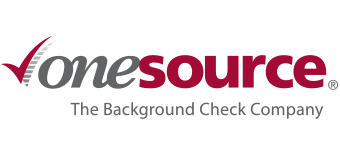Conducting background checks is a simple way to help mitigate the risk of a bad hire, but they can add some trouble right back on your organization without being done correctly.
Background checks conducted by third-party background screening firms (like One Source) are considered ‘Consumer Reports’ by the Fair Credit Reporting Act (FCRA). What does that mean? Simply put, you must adhere to their rules and regulations and ensure you comply with the plethora of federal, state, and local laws. Not complying with these rules and regulations could result in steep fines, lawsuits, and sometimes even class action settlements.
Using a Professional Background Screening Association (PBSA) accredited background screening firm is an easy step to be sure you are building a team compliantly for your organization.
Here are Four Best Practices for Compliance to ensure you have a successful blueprint for compliant background screening:
-
Background Check Policy
Before you start screening applicants for employment, it is crucial to have a policy in place. In 2012, the Equal Employment Opportunity Commission (EEOC) released its Enforcement Guidance on the use of background screening in the employment hiring process. What should this Policy include?
- Purpose – Identify the reason you are running the background check; for example pre-employment.
- Scope – What types of background checks are you running? How often are you screening applicants, upon hire, annually?
- Not sure where to start? The Society of Human Resource Management (SHRM) provides a great template to help you get started. Read more.
- Process – How will you be reviewing offenses and determining what is acceptable or not? Onboarding should be consistent within position levels when making determinations. Onboarding managers need to assess the potential risks and liabilities related to the position’s requirements to determine whether you should onboard the applicant through individualized assessments if in the context of employment.
- The EEOC recommends you consider the nature and gravity of the offense, the time that has passed since the conviction and/or completion of the sentence, and the nature of the job sought to ensure that the exclusion is essential for the position.
-
Disclosure* and Authorization
Now that you have a screening policy in place, you are ready to begin the background screening process. The next thing you need to do is obtain Disclosure and Authorization from the applicant. The FCRA outlines this for employers, and the FTC has guidance available here. Disclosures* are only required under the permissible purpose of employment.
Be sure to:
- Inform the applicant or employee that you may use the results of the consumer report for decisions related to their employment. This notice must be in writing and in a stand-alone format.
- Gather written consent from the applicant or employee. If you want to use this authorization throughout the duration of the individual’s employment, you must state that clearly and conspicuously.
- Review federal, state, and local laws and include applicable notices. Your screening vendor should provide these to you.
One Source provides all clients a compliant Disclosure and Authorization form, which you can find here.
-
Quality of Data
In the background screening world, there are two main ways that Consumer Reporting Agencies (CRAs) conduct criminal background searches. The first is by conducting real-time, original source record searches directly from the source. The second is utilizing a database or repository.
Database searches, while fast and inexpensive, provide non-compliant data. Record information is often not updated regularly and pulled from archived sources. These inconsistencies leave gaps and holes for outdated information and error galore. While these searches are often the most affordable solution, they can lead to costly lawsuits and ligation.
Be sure that your background checks include live, real-time court records. Original source records mean your vendor is going directly to the courthouse to obtain information that is up to date and as accurate as possible, eliminating errors caused by expungements, dismissed records, and recent convictions that may otherwise be missing.
-
Adverse Action
Before making a final employment decision based in whole or in part on the background check results, the employer must provide a Pre-Adverse Action Notice, a copy of the background report, and their Summary of Rights Under the FCRA.
This process allows the applicant to review their report, and if necessary, dispute the accuracy of the findings. The timing and actions required during this process are crucial to staying compliant. You can learn more about how employers and applicants should handle adverse action here.
Don’t let the compliance of background screening seem daunting. The blueprint to a compliance screening process is simple; have a rock-solid background check policy, compliant disclosure and authorization forms, quality, real-time data in your reports, and follow the adverse action process.
The best part of it all is that One Source is here to help you through the process. Reach out at any time for a free review of your process from start to finish.
